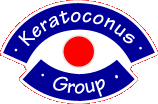This article originally appeared at www.clspectrum.com, and is kindly reproduced with permission from the author.

A common complaint of contact lens wearers, especially those with keratoconus, is that they can wear their contact lenses fairly well for several days running and then run up against several days during which they can’t manage even to insert the little beasts. Some patients have termed this situation Good Eye Days/ Bad Eye Days (GED/BED).
I would like to offer a possible explanation of why GED/BED is likely to be more prevalent among the keratoconus contact lens wearing population than those with non-conical corneas and hopefully a possible prevention or cure.
Causes
Of the many possible causes of GED/BED, I think the most likely is simply overwearing contact lenses. While many people can wear lenses for consecutive hours day after day with no readily apparent insult, there exists a particular corneal structure which tires of bearing the contact lens foreign body at some stage. We first became aware of the “overwear syndrome” (OWS) many years ago with PMMA contact lenses. After too many hours of lens wear, eyes begin to redden, tear and reject the lenses. The morning after is even worse. Many cases of OWS have been at least partially remedied with RGP materials, but some corneas still can not handle the stress of long term wear.
I think that in keratoconus we have to consider two additional factors besides the “foreign body under the lid” aspect: the predisposition of the conical cornea to react pathologically to stresses on the cellular level and on the molecular level. A series of recent laboratory studies summarized by Dr. M. Cristina Kenney in the Everett Kinsey Lecture published in the January 2000 edition of The CLAO Journal can help us understand the weakness and susceptibility of the keratoconic cornea to react badly to physical stress. While the paper ought to be read in full, I will use some of the results here.
- Molecularly, several biochemical compounds (proteins, primarily enzymes) appear in significantly different concentrations in normal corneal cells as opposed to keratoconic cells. Some compounds are more frequently found in keratoconus cells, and others which exist in normal corneas are in some cases nearly non-existent in keratoconus. The purposes of these chemicals vary. In normal corneas, the compounds which are missing in keratoconus aid the cornea in proper healing after injury, new cell growth and development, and maintaining the structural uniformity and transparency of the cornea. Those that are found in keratoconic corneas but not in normal corneas weaken the cornea’s response to UV light and other external stresses.
- Research has shown that on the cellular level, keratoconus cells will capitulate and self-destruct (apoptosis) when threatened or injured. Other studies have shown that areas of these cells will heal from injury and abrasion abnormally. This compromised healing response more often results in scars and thinner tissue than would be seen in a healthy cornea.
GED/BED
Back to GED/BED. Because seeing is optimized for keratoconus patients by wearing contact lenses (in most cases), these patients will tend to wear their lenses to the maximum. Sometimes they overrun the maximum safe wearing time. That would have been a Good Eye Day. Many keratoconus patients can wear their lenses for many successive GEDs before they suddenly encounter a BED. “Why can’t I wear my contact lenses?” cries the hapless voice over the phone. On examination and questioning, the careful clinician can discover that his patient has probably been pushing his lens wear to the limit. He is now in the throes of what may be considered a complicated OWS with exaggerated responses dictated by his compromised keratoconic cornea.
It seems that because of the peculiar biochemistry of the cells of the keratoconic cornea, this is more likely to happen to keratoconus patients than non-keratoconus patients. I propose that although a keratoconus patient needs to wear his lenses in order to function visually, he will do far better in the long run by limiting his continuous wearing time.
At each follow-up visit, I try to ask every patient how long he has worn his lenses so far today, yesterday and the day before. This helps me to understand more clearly the intricacies of contact lens adaptation.
Treatment
While keratoconus patients must be able to see efficiently, it must not be at the expense of either their immediate eye health or their capacity to wear their contact lenses on the following day. A common sense approach for these patients maintains a balance between necessary binocular wear, incidental alternating monocular wear and around-the-house spectacle wear. We must use our judgment as professionals to help our contact lens patients find the most efficacious way of avoiding the pitfalls of GED/BED.
Dr. Schendowich is a contact lens specialist at Sha’are Zedek Medical Center, Jerusalem, Israel. He is the organizer and moderator of the center’s keratoconus support group. He is also a consultant to the KC-link, an international Internet support group for keratoconus patients.

